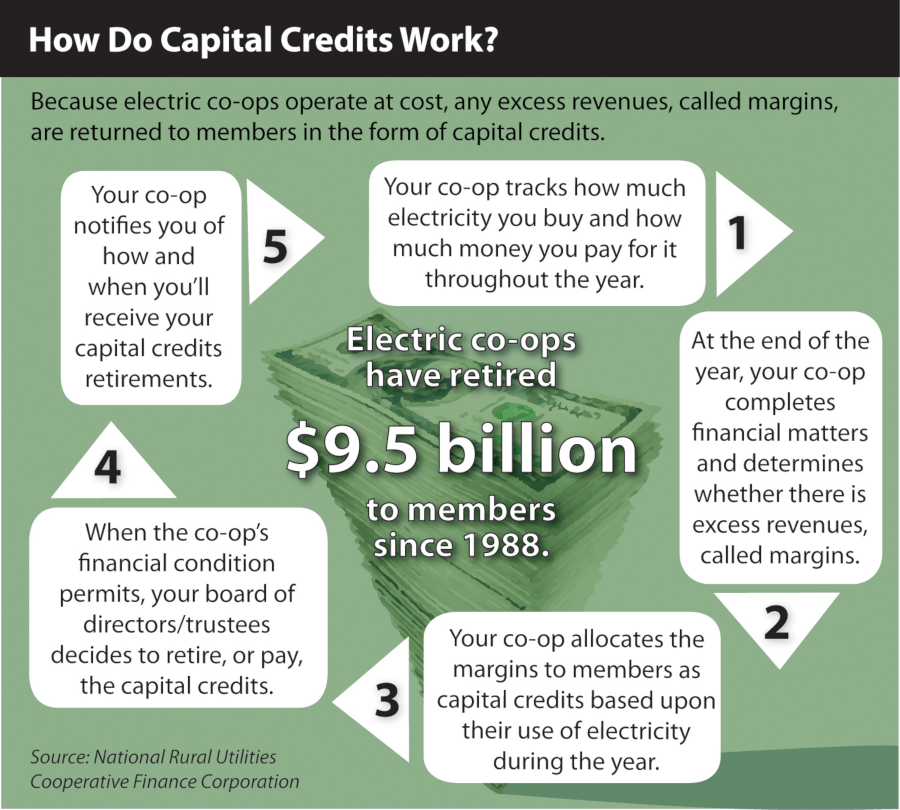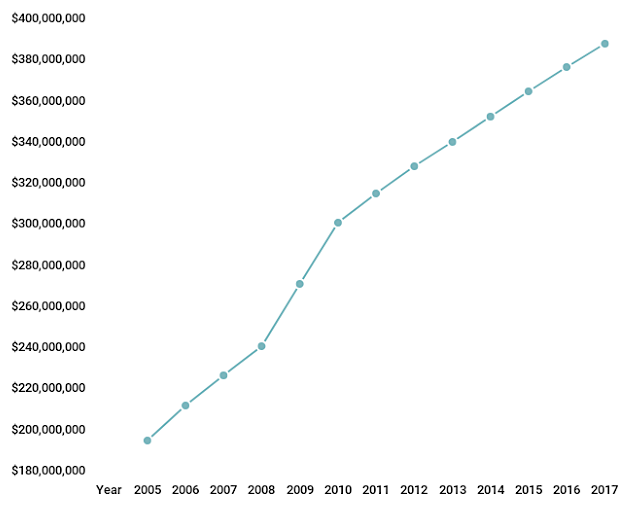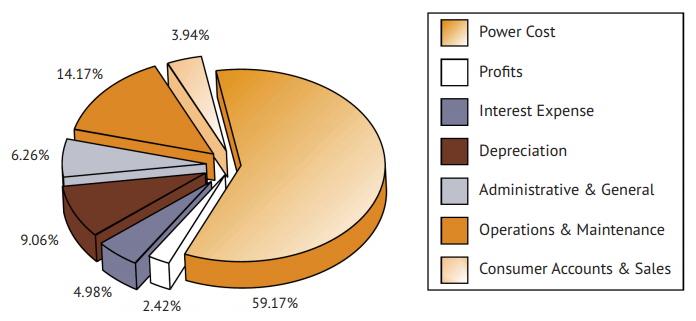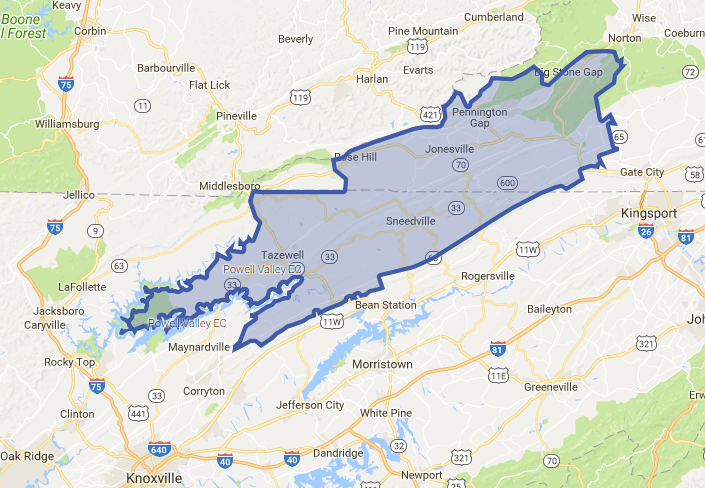
Co-op service areas
Source: Virginia, Maryland & Delaware Association of Electric Cooperatives (VMDAEC)

Co-op service areas
Source: Virginia, Maryland & Delaware Association of Electric Cooperatives (VMDAEC)
Virginia has private not-for-profit cooperatives (co-ops) that provide electricity to customers in about 1/3 of the state. Each co-op has a specific service area defined by the State Corporation Commission (SCC) where they have a monopoly to provide electricity. There are 13 co-ops:1
The electric co-ops are businesses owned by their members, in contrast to municipal utilities owned by cities or for-profit utilities owned by investors. Rates charged to customers provide the funds needed for a co-op to purchase electricity, pay staff for operations, and finance capital improvements such as replacement of distribution lines and substations.
Rates are set high enough so there will be sufficient capital to cover planned expansion of infrastructure such as transmission lines and unexpected expenses, such as repairs after a major storm. An assessment of reserves may reveal an excess capital, which non-profits must return to members. Electric co-ops return that portion of the surplus that was collected years earlier to members as "capital credits" rather than as "dividends." To ensure sufficient money is in the bank, co-ops hold onto about 20 years of excess capital.
Each year, the co-op board determines how much is needed and determines if there is an excess to distribute back to the members/customers who had contributed the capital. Between 1989-1994, the Northern Virginia Electric Cooperative needed to conserve capital in order to finance operations and expansion of infrastructure. No capital credits were returned to customers during that five year period.
Co-ops maintain a list of members who are entitled to receive capital credits. People who move out of the co-op's service area are still entitled to receive capital credits from over-payments made when they were customers/members a decade or two earlier, but must ensure the co-op has a current address in order to provide the refund. In 2017, the Southside Electric Cooperative returned capital credits to 43,767 active and 14,452 inactive cooperative members.2

Southside Electric Cooperative service area
Source: Southside Electric Cooperative, Map of Service Area
In 2017 the Craig-Botetourt Electric Cooperative returned $650,000 to people who had been members in 1989 and 1990. The cooperative had set rates high enough in those two years to provide a cushion of extra capital, but determined almost 20 years later that reserves were sufficient and refunds could be issued. It explained the process as follows:3

members of electric cooperatives get refunds (capital credits) if rates exceeded costs for managing infrastructure
Source: Southside Electric Cooperative, Capital Credits Q&A
The National Rural Electric Cooperative Association (NRECA) suggests cooperatives return funds that was not spent within 20 years, but Virginia's cooperative usually retain excess capital for a shorter period before returning them.
Returning capital credits to members is challenging because of the delay between collecting and releasing the money. Members who move away do not get an automatic credit on their bill, and often do not receive notices mailed to the service address. Cooperatives publish a list of members who have not claimed their credits, which is often less than $100, but Virginia co-ops do not normally notify members how much capital credit has accumulated in their name.
In 2018, the Rappahannock Electric Cooperative had accumulated $400 million in capital and decided that $7.8 million was surplus to be returned to members as capital credits. The Virginia co-op was beginning to receive significant refunds from its power supplier, Old Dominion Electric Cooperative (ODEC). That money had been paid by each co-op to the power supplier, but ultimately was not needed to construct new generation capability.
Old Dominion Electric Cooperative was returning money that had been held for two decades, so the number of co-op members to be notified about capital credits was far larger. Instead of publishing a list of 500-800 members entitled to a refund who had not been found, in 2020 the co-op published a list of 21,000 members.5

Rappahannock Electric Cooperative dramatically increased its capital reserves after 2000
Source: RepowerREC, Capital credits, and how REC fails to inform its members about them
Customers of an electric co-op are also voting members of the organization, and elect the co-op's governing board. The State Corporation Commission regulates electric co-ops, and can be a factor in governance of the co-op if the board is unresponsive to member concerns.
The co-ops developed in the 1930's, when rural areas were unable to get private companies to build electricity lines built to their farms and small towns. Major utilities were busy creating infrastructure to serve the denser population areas, and some towns/cities built municipal systems.
To build the initial electrical grid, investor-owned utilities focused on serving the greatest number of customers requiring the least amount of capital. That approach maximized the return on private investment. It was mimicked a century later, when for-profit companies like Verizon built networks to provide internet service in areas of high population density and rural customers struggled to get a high-speed connection.
During the Great Depression, the new federal Rural Electrification Administration initially offered low-cost loans to investor-owned utilities to expand their grid to service customers located far from population centers. When the response from the private sector was low, the Federal program expanded to support farmer-based co-ops that would build at least 100 miles of powerlines to serve at least 300 customers.
At the time, about 10% of rural residents received electricity from the grid. Kerosene-fueled lights could illuminate rooms at night, and kerosene-fueled refrigerators could keep food cool. Firewood could keep houses warm and heat food. Long hours to heat water and do the laundry could keep clothes clean.
Federal financing allowed member-owned cooperatives to fund new power lines and other infrastructure. By 1950, 80% of rural residents were connected and could flip a switch to turn on lights, cook meals, heat homes, and wash clothes. By 1960, 97% of rural residents received electricity from the grid. One delighted farmer told his neighbors after getting connected:6
Since most rural residents in the Great Depression were farmers, the Rural Electrification Administration was placed in the US Department of Agriculture in 1937. It was incorporated into the Rural Utilities Service in 1994.
The US Department of Agriculture continues to provide low-cost loans to electric cooperatives. Most cooperatives are still serving rural areas with low population density. The Southside Electric Cooperative averages just six electric meters per mile of powerline.7

the greatest percentage of costs for Southside Electric Cooperative is the purchase of electricity
Source: Southside Electric Cooperative, 2016-2017 Annual Report (p.10)
Some cooperatives now service suburban customers, after farms and forests near urban core areas have developed. In 1983, after the energy crises of the 1970's, the Northern Virginia Electric Cooperative (NOVEC) was formed by the consolidation of Tri-County Electric Cooperative (started 1939) and Prince William Electric Cooperative (started 1941).
Virginia's experiment with the deregulation of electricity did not include altering the service area boundaries of co-ops, municipals, and investor-owned (i.e., private) utilities. Each retained its exclusive distribution areas, as defined by the State Corporation Commission.
The co-ops work together to increase both their buying power and their political influence. The National Rural Electric Cooperative Association (NRECA) was formed in 1942 to ensure the small co-ops had a sufficient voice in Washington, DC. One of the first challenges was to counter the claim that the co-ops were hoarding copper wire during World War II.
The co-ops obtain much of the electricity that they distribute today through contracts with other companies, particularly the Dominion Generation subsidiary of Dominion. The Old Dominion Electric Cooperative (ODEC) supplies an alliance of 11 co-ops.
The Powell Valley Electric Cooperative purchases its electricity from the Tennessee Valley Authority (TVA).8

the Powell Valley Electric Cooperative service area extends outside of Virginia into northeast Tennessee
Source: Powell Valley Electric Cooperative, About

the Federal government funded the delivery of electricity to isolared rural houses
Source: Tennessee Valley Authority (TVA), Toward Electified America (1934)